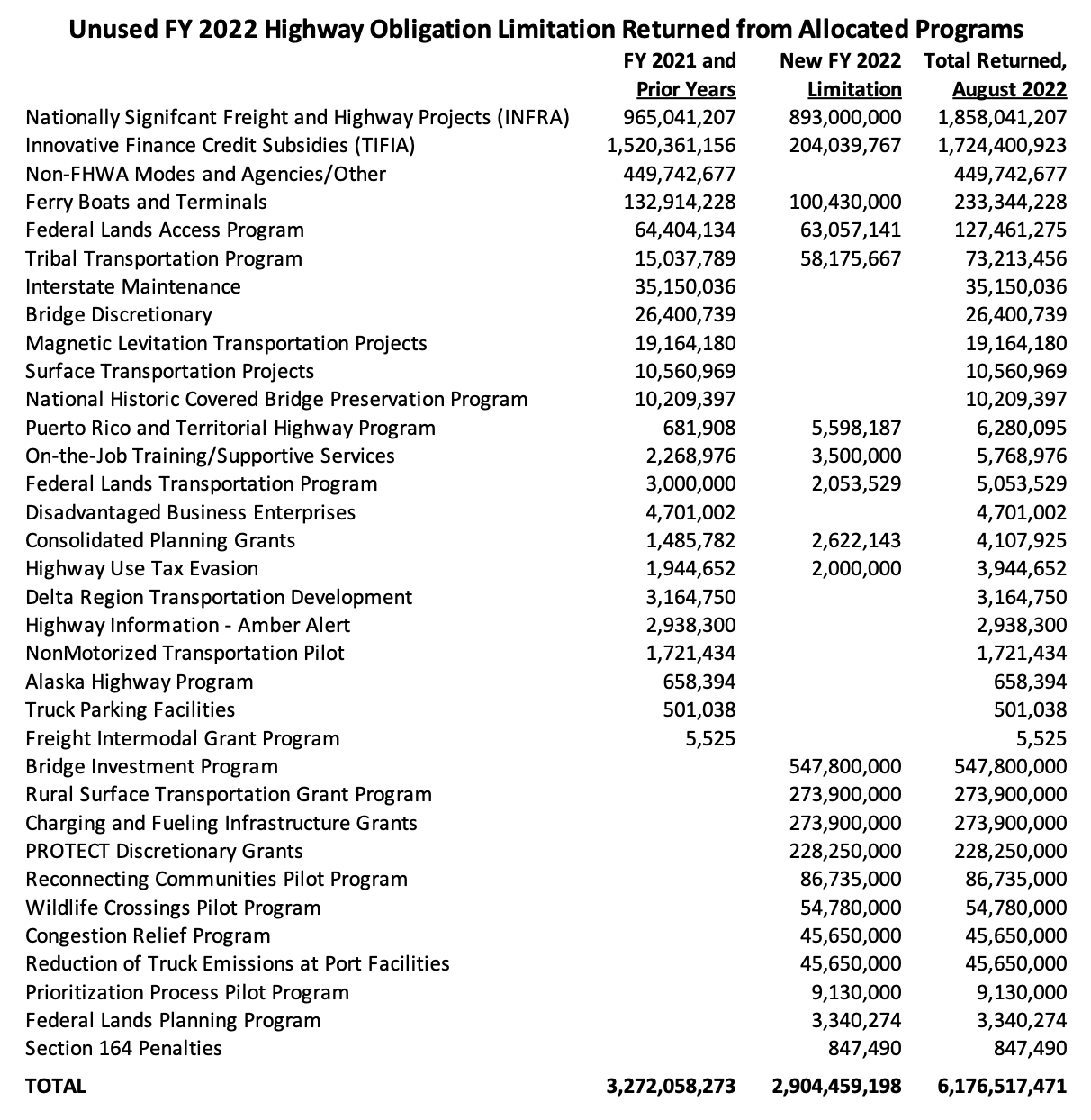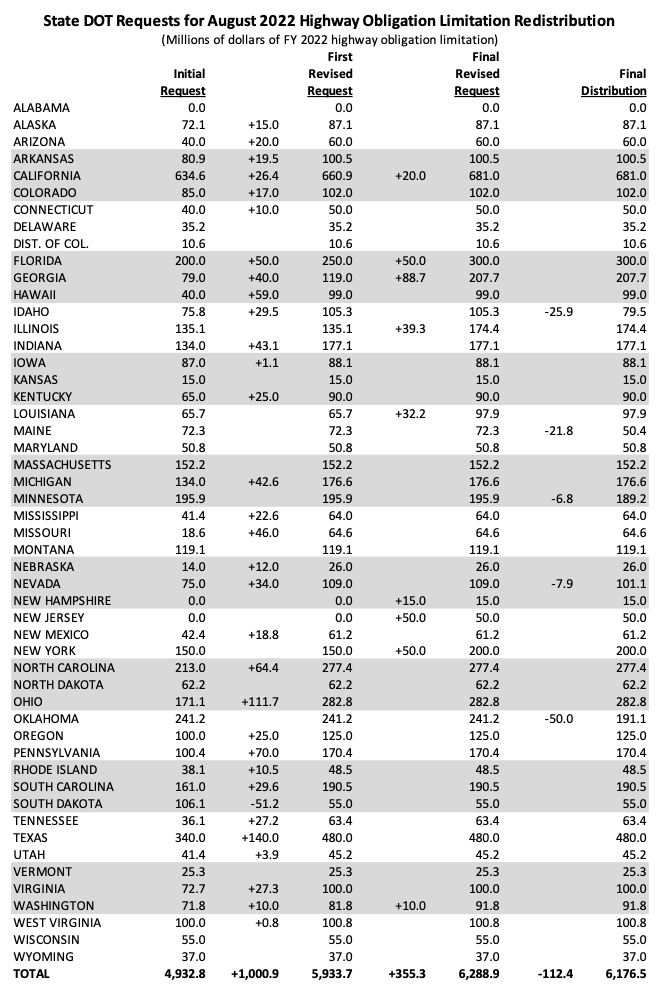Every year, the total amount of funding that can be legally obligated for expenditure by the federal-aid highway program is limited by a provision in the annual appropriations bill. For example, for fiscal year 2022, the appropriations act said “Funds available for the implementation or execution of authorized Federal-aid highway and highway safety construction programs shall not exceed total obligations of $57,473,430,072 for fiscal year 2022.”
This is use-it-or-lose-it spending permission, and in order to make sure that every dollar of it gets used, the Federal Highway Administration effectively shuts down its non-formula programs at the end of July every year, preventing them from signing any large grant agreements that weren’t already scheduled until after September 30. The managers of these non-formula programs (called allocated programs) then return their unused obligation limitation back to the FHWA head office, which is already in the process of asking state DOTs how much additional funding they think they can obligate by the end of the fiscal year.
The way it normally works is: states collectively ask for X, the amount that the allocated programs turn in adds up to 70 or 80 percent of x, and FHWA then gives that extra money back to states so they can go on a spree of contract-signing by the end of the federal fiscal year.
Last August, this process broke down. FHWA had to go back to states, not once, but twice, and implore them to ask for more money to avoid the nightmare scenario of letting hundreds of millions of dollars in highway funding lapse, unspent, in the first year of the bipartisan infrastructure law.
At the time, FHWA wouldn’t say which programs produced the all-time high August redistribution, or which states successively upped their game. But the Freedom of Information Act is a wonderful thing, and ETW’s FOIA request has now been processed.
The August Redistribution keeps getting bigger
The August redistribution has been a part of the obligation limitation process since the 1980s, but the amounts were relatively negligible. In the late 2000s, only about 3 percent of the annual obligation limitation got redistributed in August (a little over $1 billion per year). By FY 2020, because of the growth in slow-spending non-formula programs, the AR had grown to 10.3 percent of the total. 2022’s AR was 10.7 percent of the total, but because of the bipartisan infrastructure law’s spending increase, that was 10.7 percent of a much higher total, so the AR jumped from $4.8 billion in 2020 to $6.2 billion in 2022.
| FY |
Total Ob. Limit. |
August. Redist. |
Pct. |
| 2007 |
$39,086,464,683 |
$1,223,675,007 |
3.1% |
| 2008 |
$41,216,051,359 |
$1,160,367,604 |
2.8% |
| 2009 |
$40,700,000,000 |
$1,028,541,567 |
2.5% |
| 2010 |
$41,107,000,000 |
$1,336,569,692 |
3.3% |
| 2011 |
$41,107,000,000 |
$1,182,665,012 |
2.9% |
| 2012 |
$39,143,582,670 |
$1,400,464,387 |
3.6% |
| 2013 |
$39,619,602,000 |
$3,137,048,104 |
7.9% |
| 2014 |
$40,256,000,000 |
$1,595,648,530 |
4.0% |
| 2015 |
$40,256,000,000 |
$2,117,694,862 |
5.0% |
| 2016 |
$42,361,000,000 |
$1,906,572,178 |
4.4% |
| 2017 |
$43,266,100,000 |
$2,832,803,208 |
6.5% |
| 2018 |
$44,234,212,000 |
$4,183,936,196 |
9.5% |
| 2019 |
$45,268,596,000 |
$3,972,743,240 |
8.8% |
| 2020 |
$46,365,092,000 |
$4,762,052,903 |
10.3% |
| 2021 |
$46,365,092,000 |
$4,178,016,327 |
9.0% |
| 2022 |
$57,473,430,072 |
$6,176,517,471 |
10.7% |
2022 – How it happened
On June 30, 2022, FHWA sent the state DOTs Notice 4520.275, laying out the timetable for the FY 2022 AR process. States were told to submit their requests for extra funding (along with a detailed plan for how they would spend it) to their FHWA division offices by July 14. At the same time, FHWA asked all of its offices to return all of the obligation limitation they didn’t think they would be able to use, and to do so by August 5.
By August 9, FHWA knew they had a problem. An email to the Chief Financial Officer said “It looks like we will have approximately $5.7 billion in limitation returned for August Redistribution. However, this year is significantly undersubscribed. States have only requested approximately $4.9 billion in additional limitation, which means we have the potential to lapse about $800 million in limitation. Three States requested no additional limitation; we went back to those States today to verify that they still aren’t requesting anything. Two of the three have responded that they still don’t want any additional limitation this year; we are waiting for confirmation from the third State.”
Accordingly, FHWA sent out an email at 8:30 the next morning (August 10) to all of its division administrators telling them to get with their state DOT immediately and ask them if they wanted to revise their AR requests upward, and that they would have until the close of business on August 11 to do so.
32 states collectively increased their requests by $1.001 billion, from $4.933 billion to $5.934 billion. Some of the increased requests were as large as +$140 million (Texas) or +$111.7 million (Ohio), but some were as small as +$1.1 million (Iowa) or just $840 thousand (West Virginia). This prompted another internal email to the CFO on the morning of August 12:
“We have received revised responses from most of the States. There are still a couple of States that requested an extension until COB today, which is fine. Based on the revised responses received so far, we are now at ~$5.9 billion in requests against ~$5.4 billion in released limitation that has been confirmed. The Office of Operations is still trying to verify that they can release an additional $319 million (Congestion Relief and Rural Surface Transportation) for A.R.. If that amount ends up being released, we will be around $5.7 billion. We are also awaiting information from the Budget Execution Team on the amount of carryover cushion that will be released; such amount is usually in the $50 -$100 million range. Based on the information we have now, it appears that we will avoid the situation of A.R. being undersubscribed (and the resulting headaches that come with such ). Our plan is to finalize everything by Monday and start routing the notice on Tuesday of next week. If anything changes significantly, we’ll be sure to let you know.”
What the email referred to as “carryover cushion” is actually the obligation limitation that FHWA has to provide, along with contract authority, to non-FHWA agencies to administer certain programs. These can be agencies inside the Department of Transportation (MARAD and NHTSA have the most, but FRA, OST-R, FTA and FMCSA each have a little), or the can be outside DOT (five different bureaus and services at Interior, plus the Forest Service, the IRS, and the Army Corps of Engineers). As it turns out, that cushion, was more than expected, as reported to the FWHA CFO the morning of August 15:
“We received the amount of carryover cushion that is being returned and it was significantly higher than I was expecting. Historically, the amount returned has been in the range of $50M-$100M. However, this year, the amount being returned is $450M. This has again put us in the situation where August Redistribution is undersubscribed. States have requested $5.93 billion (which is a billion more than originally requested) and the total being returned is $6.18 billion. Thus, we are likely going to lapse about $250M in limitation.”
Here are the sources of the unused allocated obligation limitation returned during the 2022 August redistribution, totaling $6.177 billion.

States had increased their request to $5.934 billion, but FHWA still had $6.172 billion to give out, so $245 million was at risk of lapse.
FWHA then had to make the had decision to go back to states a second time and ask them to increase their requests once more. Nine states did so, from Washington State (+$10 million) to Georgia (+$88.7 million), for a total increase of $355.3 million, to $6.289 billion.(The full table is at the end of this article.)
Finally, they had more than enough demand to take all the supply. FHWA then began the process of paring back the state requests slightly, giving five states (Idaho, Maine, Minnesota, Nevada, and Oklahoma) a collective $112.4 million less than they asked for. The redistribution notice (N 4520.276) went out to states on August 29.
Another close call is almost assured in August 2023. The obligation limitation (and new contract authority subject to the limit) is $1.3 billion higher in 2023 than in 2022 but the amount of obligation limitation initially reserved for allocated programs rose by $2.2 billion (to $12.25 billion), and that could mean an AR in the $7.3 to $7.4 billion range this time. And at the same time, states may have less contract authority to obligate than they thought they had (see this Feb. 3 ETW summary of the situation).
Because of all this, on January 6, the head of the organization of state DOTs (AASHTO) wrote to the Federal Highway Administrator on behalf of all the states, complaining that “Such a large redistribution created significant difficulties for state DOTs to effectively program these dollars within a very narrow timeframe of about a month before the end of the federal fiscal year.”
The letter cited the traditional slow spendout rates of the TIFIA and INFRA program, and the influx of new funding for allocated programs from the IIJA, as having “led to state DOTs seeing a corresponding and relative decrease in their amount of formula obligation limitation at the beginning of the fiscal year, which deprives them of the time window which would otherwise better enable them to strategically deploy IIJA dollars throughout the full fiscal year.”
The letter ended by asking FWHA to “inform state DOTs at the beginning of each federal fiscal year regarding the amount of carryover balance for every allocated program, and provide a monthly update of these balances for the remainder of the fiscal year. This information will help state DOTs to better optimize their programming of federal dollars throughout the year, including their ability to plan for larger AR amounts.”
So far, however, there does not appear to have been any response by FHWA to AASHTO’s letter.






